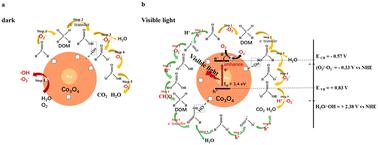当前位置:
X-MOL 学术
›
Environ. Sci.: Nano
›
论文详情
Our official English website, www.x-mol.net, welcomes your
feedback! (Note: you will need to create a separate account there.)
Catalytic oxidation of formaldehyde over a Au@Co3O4 nanocomposite catalyst enhanced by visible light: moisture indispensability and reaction mechanism
Environmental Science: Nano ( IF 5.8 ) Pub Date : 2022-09-22 , DOI: 10.1039/d2en00679k Qiuxia Liu 1, 2 , Yuelong Wang 1, 2 , Meicheng Wen 1, 2 , Yunlong Guo 1, 2 , Yupeng Wei 1, 2 , Guiying Li 1, 2 , Taicheng An 1, 2
Environmental Science: Nano ( IF 5.8 ) Pub Date : 2022-09-22 , DOI: 10.1039/d2en00679k Qiuxia Liu 1, 2 , Yuelong Wang 1, 2 , Meicheng Wen 1, 2 , Yunlong Guo 1, 2 , Yupeng Wei 1, 2 , Guiying Li 1, 2 , Taicheng An 1, 2
Affiliation

|
Formaldehyde has strong carcinogenic and cancer-promoting effects, and its removal from indoor air is still challenging. Transition metal oxides such as cobalt(II,III) oxide (Co3O4) are potential catalysts to eliminate formaldehyde. However, the inherent low activity of Co3O4 at room temperature has greatly limited its utilization for indoor air purification. In this work, an extremely facile and mild method was designed to prepare a Au@Co3O4 core–shell nanocomposite catalyst, and its catalytic and photocatalytic activities for formaldehyde oxidation were determined both under dark conditions and visible-light irradiation. This material exhibited not only high catalytic formaldehyde oxidation efficiency in the absence of light but also significantly promoted photocatalytic formaldehyde oxidation activity under visible-light irradiation. Electron paramagnetic resonance and in situ diffuse reflectance infrared Fourier transform spectroscopy were applied to identify the reactive oxygen species and the produced degradation intermediates which adsorbed onto the surface of the catalyst during the oxidation process. It was found that the enhanced catalytic activity of the Au@Co3O4 nanocomposite catalyst under visible-light irradiation was mainly attributed to the promotion of oxygen and formaldehyde activation by the photogenerated carriers, facilitating the formation of dioxymethylene and thereby accelerating the key step of the generation of formic acid and carbonate species. This fundamental study provides evidence for a catalytic mechanism of the photocatalytic degradation of formaldehyde and a basis for the rational design of catalysts that efficiently eliminate indoor formaldehyde through full use of visible light.
中文翻译:

可见光增强的 Au@Co3O4 纳米复合催化剂催化甲醛氧化:水分的必要性和反应机理
甲醛具有很强的致癌和促癌作用,从室内空气中去除它仍然具有挑战性。过渡金属氧化物如氧化钴( II , III ) (Co 3 O 4 ) 是消除甲醛的潜在催化剂。然而,Co 3 O 4在室温下固有的低活性极大地限制了其在室内空气净化中的应用。在这项工作中,设计了一种极其简便和温和的方法来制备 Au@Co 3 O 4在黑暗条件和可见光照射下测定了核壳纳米复合催化剂及其对甲醛氧化的催化和光催化活性。该材料不仅在无光条件下表现出较高的催化甲醛氧化效率,而且在可见光照射下显着提高了光催化甲醛氧化活性。应用电子顺磁共振和原位漫反射红外傅里叶变换光谱识别氧化过程中吸附在催化剂表面的活性氧和产生的降解中间体。发现Au@Co 3 O 4的催化活性增强可见光照射下的纳米复合催化剂主要是由于光生载体促进了氧和甲醛的活化,促进了二甲醛的形成,从而加速了甲酸和碳酸盐物种生成的关键步骤。这项基础研究为甲醛光催化降解的催化机制提供了证据,并为合理设计通过充分利用可见光有效消除室内甲醛的催化剂提供了依据。
更新日期:2022-09-22
中文翻译:

可见光增强的 Au@Co3O4 纳米复合催化剂催化甲醛氧化:水分的必要性和反应机理
甲醛具有很强的致癌和促癌作用,从室内空气中去除它仍然具有挑战性。过渡金属氧化物如氧化钴( II , III ) (Co 3 O 4 ) 是消除甲醛的潜在催化剂。然而,Co 3 O 4在室温下固有的低活性极大地限制了其在室内空气净化中的应用。在这项工作中,设计了一种极其简便和温和的方法来制备 Au@Co 3 O 4在黑暗条件和可见光照射下测定了核壳纳米复合催化剂及其对甲醛氧化的催化和光催化活性。该材料不仅在无光条件下表现出较高的催化甲醛氧化效率,而且在可见光照射下显着提高了光催化甲醛氧化活性。应用电子顺磁共振和原位漫反射红外傅里叶变换光谱识别氧化过程中吸附在催化剂表面的活性氧和产生的降解中间体。发现Au@Co 3 O 4的催化活性增强可见光照射下的纳米复合催化剂主要是由于光生载体促进了氧和甲醛的活化,促进了二甲醛的形成,从而加速了甲酸和碳酸盐物种生成的关键步骤。这项基础研究为甲醛光催化降解的催化机制提供了证据,并为合理设计通过充分利用可见光有效消除室内甲醛的催化剂提供了依据。










































 京公网安备 11010802027423号
京公网安备 11010802027423号